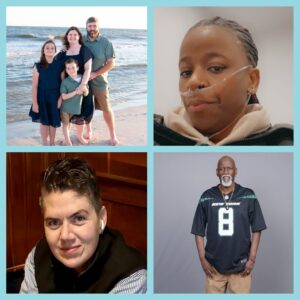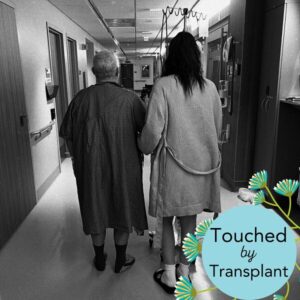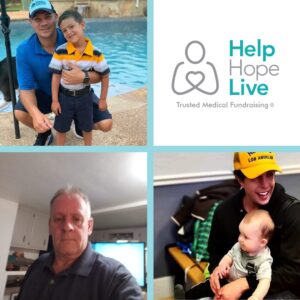Nick Karavite was diagnosed with a rare blood disease called aplastic anemia at age 13. His bone marrow stopped producing enough vital blood cell varieties which caused his immune system to attack itself. Nick’s treatment included extended hospital stays and testing, chemotherapy and, finally, a bone marrow transplant from his 6-year-old sister, Mandy, exactly one year ago today. We spoke to Nick and his mother, Pam, about his transplant journey.
Walk us through the first few days.
Pam: To be honest, everything happened so fast that none of us had much time to process it. One day Nick was pitching a no-hitter, and the next day he had red spots all over him, a fever and exhaustion. I took him to the pediatrician and they did blood work and immediately sent us to the hospital. We were met by an entourage of doctors and nurses and escorted right to another room – no E.R., no waiting room. By the next morning, a bone marrow biopsy was performed and he was diagnosed with aplastic anemia.
We went from a routine visit to the pediatrician on Monday to hearing that our son could die on Wednesday. There just wasn’t any time to think, just react.
How much did you know about aplastic anemia when you were first diagnosed?
Nick: I didn’t know anything about aplastic anemia, and I had never heard of the disease before. In fact, nobody in my family had any experience with the disease. Even though I knew nothing at the beginning, I could probably tell you everything about the whole process at this point!
HelpHOPELive: Aplastic anemia is a rare disorder that causes an individual’s immune system to attack and destroy the body’s bone marrow. Fewer than 1,000 cases are diagnosed annually in the U.S. It is uncertain what causes aplastic anemia to occur.
Was your family worried about you?
Nick: Yes, my family members were very worried. My mom would think about it every single night as she watched me sleep – she wanted to change places with me. But they didn’t let that worry get in the way. The same goes for my friends. Instead of overloading me with questions about it, they just cared for me.
Pam: We had our moments (I call them 80/20 days). Nick’s doctor told us that even with his sister, Mandy, as a bone marrow match, his chance of survival was 80%. I had days where I couldn’t shake the 20%. Once, I was packing a bag in Nick’s closet before heading back to the hospital and I had a vision of packing up his closet for good. I fell apart, began sobbing, sniffing his clothes, falling to my knees and begging God to leave my son here. I started calling them ‘closet moments’ – if I ever needed to cry, I would go find a closet so that Nick never knew.
Were you scared?
Nick: I wasn’t too scared, because I honestly didn’t know what was going to happen. I was learning more about the condition and focusing on what needed to happen next. I guess there is mild, moderate and severe aplastic anemia. I had severe aplastic anemia, but my parents never shared that or my survival odds with me until after I made it through.
What helped your family remain positive?
Pam: We were united in our common love for Nick, but I feel we remained positive because of God’s hand in things. I spent a lot of nights watching Nick sleep, wondering why this was happening. I still am not clear as to the “why,” but I am sure that God had a hand in preparing us for this battle for three reasons.
First, five years ago, God blessed us with the surprise of Mandy, who ended up being Nick’s ideal bone marrow match. Second, I had started work on my Masters in Special Education before Nick’s diagnosis, which equipped me perfectly to home school Nick for three quarters of his 8th grade year while he pursued treatment. Third, we moved our children to a different school district prior to his diagnosis, and the support of this new community became a true lifeline for our family when Nick was diagnosed.
The community really rallied to keep us lifted. Local parents put us in touch with HelpHOPELive, helped us cook meals and clean and held fundraisers in Nick’s honor. His peers at school even donated their allowance to his campaign. Teachers went above and beyond for Nick – his basketball coach gave him an honorary spot on the team even though he wouldn’t be able to play. Based on all we were armed with for this fight, it was hard not to remain positive.
Was fundraising an important part of the journey?
Pam: Fundraising was a HUGE part of our journey. The money raised through HelpHOPELive helped with anything insurance didn’t cover; the greatest help was when it allowed us to relocate for Nick’s hospital stay. One of the smartest things we did was to keep our family together: from the very beginning, I knew we needed to be at Nick’s side at the hospital 24/7. I knew we had Nick, the sick boy; Mandy, the donor; and two other boys that could potentially get lost in the shuffle. We agreed that keeping together was the best way to maintain some kind of ‘normal’.
Because of the help we received via donations from family and friends, one of us was able to be at Nick’s side every step of the way, and the other parent could be with our other children to provide them with ‘normal’ family time. Our psychologist has since told us that this one act, keeping our family together, was instrumental in getting us through this journey with the least amount of upheaval. Fundraising made that possible for us.
What was the treatment like?
Nick: I went through a few treatments and then chemotherapy. I didn’t realize how sick it would make me. I got chemo for four days. Every night, all I could think about was being one day closer to going home again.
The bone marrow transplant only took a couple of hours, but I had to stay in the hospital for a month afterwards. A lot of people brought me games and things to do in the hospital to pass the time. I wasn’t able to eat for the first two weeks! The doctors wanted me to fill up on protein, but until I could get there, I had to get liquid nutrients through an IV for every single meal to stay healthy. I have a few scars from the treatment process.
What three words would you use to describe how it feels to go through diagnosis and treatment?
Nick: Scary. Unknowing. Shocked.
What advice would you give to another family that is facing a battle with aplastic anemia?
Pam: Well, there is always the obvious: stay off the Internet! I didn’t allow myself to look at how awful this disease can be until after I felt good about where Nick was in his treatment. But my central piece of advice is this: accept help. I can be terrible at doing this myself, but the help we received SAVED us. It is a very humbling experience but a very necessary piece to surviving such a trying ordeal. The emotional scars are certainly here to stay for all of us, but I can honestly say they would be far worse had we not accepted the help everyone so willingly offered.
What do you think everyone out there should know about aplastic anemia or becoming a bone marrow donor?
Nick: They should know that the treatment process is a lot harder than it sounds. Even though it’s not cancer, aplastic anemia can be harder to treat than leukemia.
The chances of living with aplastic anemia without a donor are 50%. It goes up to 80% with a donor. Not only that, but the bone marrow donation process is pretty much painless – all they do is put an IV in you and put you to sleep, then take your bone marrow. The donor’s cells replenish themselves in 4 to 6 weeks.
My 6-year-old sister was my donor, and her least favorite part was the over-the-counter medicine she took after the procedure – she didn’t like the taste of it! She was able to keep going with her life right after the procedure. She was out swimming the next day!
Everyone should sign up to be a bone marrow donor. All you have to do is sign up, swab your cheeks and that’s it, and you can save a life.
You just graduated from eighth grade. What are you looking forward to in high school?
Nick: I’m excited about starting a few different classes like biology and math. Science and math are my best subjects. I’ll also have about 15 of my friends starting high school with me.
What do you want to be when you grow up?
Nick: I love baseball and I would definitely like to play baseball professionally, but I know that might be a long shot. After going through this treatment, one of my career goals is to be an anesthesiologist. Whenever I had a surgery or treatment, I would ask about anesthesia and being an anesthesiologist. It’s a really interesting system. It puts you to sleep very fast! That was a memorable experience.
Baseball is one of your favorite pastimes. What is it that you love about the game?
Nick: I like hitting, pitching, fielding, playing on a team, all of it! I’ve been playing baseball since I was four and started off with tee-ball. My favorite professional teams are the Cubs and Tigers. I’ve been to a Tigers game before. My favorite pitcher is David Price, who pitches for the Tigers. He’s a leftie like me, and he’s a good pitcher.
What’s your best pitch?
Nick: Every pitch is my best pitch!
Thank you for the great conversation, Nick and Pam. To learn more about Nick or donate to HelpHOPELive in his honor, visit his Campaign Page.











